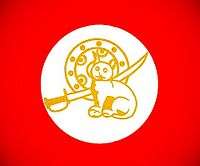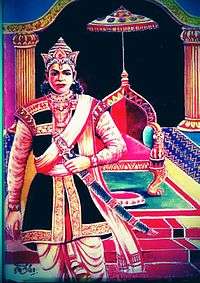Ratnadhwajpal
| Ratnadhawajpal | |
|---|---|
| Gaurinarayan | |
|
Modern representation of Ratnadhwajpal | |
| Reign | 1210 - 1250 |
| Coronation | 1210 |
| Predecessor | Birpal |
| Successor | Vijayadhwajpal |
| House | Sutiya Dynasty |
| Father | Birpal |
| Sutiya dynasty | |
|---|---|
|
Part of History of Assam  | |
| Kings of Sutiya kingdom (1187 - 1524) | |
| Birpal | 1187- 1210 |
| Ratnadhwajpal | 1210- 1250 |
| Vijayadhwajpal | 1250- 1270 |
| Vikramadhwajpal | 1270- 1285 |
| Gauradhwajpal | 1285- 1305 |
| Sankhadhwajpal | 1305- 1325 |
| Mayuradhwajpal | 1325- 1343 |
| Jayadhwajpal | 1343- 1360 |
| Karmadhwajpal | 1360- 1380 |
| Satyanarayan | 1380- 1400 |
| Laksminarayan | 1400- 1420 |
| Dharmanarayan | 1420- 1445 |
| Pratyashnarayan | 1445- 1465 |
| Yasnarayan | 1465- 1480 |
| Purnadhabnarayan | 1480- 1500 |
| Dharmadhajpal | 1500- 1522 |
| Nityapal | 1522- 1524 |
| Sutiya monarchy data | |
|
Swarnagiri Ratnapur Sadiya (Capitals of the kingdom) | |
| Peacock Flag (Royal Flag) | |
| Golden cat and sword (Coats of arms) | |
| Sutiya Buranji (Chronicle) | |
Ratnadhwajpal, was the son of Birpal and the second ruler of the Sutiya kingdom in the 13th century. He reigned for almost 40 years and was responsible for making Shaktism as a main religion of Sutiya kingdom.[1]
Considered among the most powerful kings of the Sutiya dynasty, he was known for defeating the Pal kings of Bhadrasena and Nyayapal and for his expeditions of Kamatapur. In the mid 13th century, he made friends with the Gauda ruler Khesav Sen and sent one of his son to that country for education.[2]
In 1224, he shifted the capital of the kingdom from Swarnagiri to Ratnapur (near present Majuli) and later to erstwhile Sadiya around 1248.[3]
References
- ↑ (Prakash 2007:267)
- ↑ (Prakash 2007:267)
- ↑ (Prakash 2007:267)
This article is issued from Wikipedia - version of the 11/20/2015. The text is available under the Creative Commons Attribution/Share Alike but additional terms may apply for the media files.
